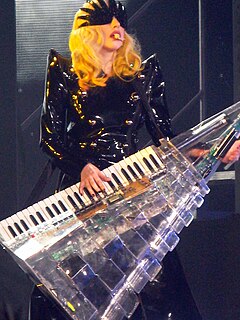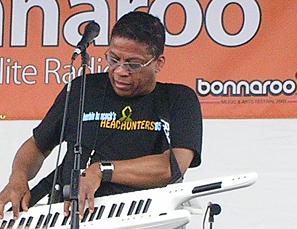
MIDI is a technical standard that describes a communications protocol, digital interface, and electrical connectors that connect a wide variety of electronic musical instruments, computers, and related audio devices for playing, editing, and recording music. The specification originates in the paper Universal Synthesizer Interface published by Dave Smith and Chet Wood of Sequential Circuits at the 1981 Audio Engineering Society conference in New York City.
General MIDI is a standardized specification for electronic musical instruments that respond to MIDI messages. GM was developed by the American MIDI Manufacturers Association (MMA) and the Japan MIDI Standards Committee (JMSC) and first published in 1991. The official specification is available in English from the MMA, bound together with the MIDI 1.0 specification, and in Japanese from the Association of Musical Electronic Industry (AMEI).

The Roland JX-3P is a synthesizer produced by Roland Corporation of Japan from 1983-1985. The "3P" in its name refers to "Programmable Preset Polyphonic". It is notable as one of the company's first synthesizers to incorporate a MIDI interface.

The keytar is a lightweight synthesizer that is supported by a strap around the neck and shoulders, similar to the way a guitar is supported by a strap. Keytars allow players a greater range of movement onstage, compared to conventional keyboards, which are placed on stationary stands or which are part of heavy, floor-mounted structures. The instrument has a musical keyboard for triggering musical notes and sounds. Various controls are placed on the instrument's "neck", including those for pitch bends, vibrato, portamento, and sustain.
The Yamaha SHS-10, known in Yamaha's native country, Japan, as the Yamaha Sholky, Sholky being derived from "Shoulder Keyboard", is a keytar manufactured by Yamaha and released in 1987.

The Jupiter-8, or JP-8, is an eight-voice polyphonic analog subtractive synthesizer introduced by Roland Corporation in early 1981.

A stage piano is an electronic musical instrument designed for use in live performance on a stage or a studio, as well as for music recording in jazz and popular music. While stage pianos share some of the same features as digital pianos designed for home use and synthesizers, they have a number of features which set them apart. Stage pianos usually provide a smaller number of sounds, with these sounds being of higher quality, unlike regular digital pianos and home synthesizers.

The microKORG is a MIDI-capable digital synthesizer/vocoder from Korg featuring DSP analog modelling. The synthesizer is built in such a way that it is essentially a Korg MS-2000 with programmable step arpeggiator, a less advanced vocoder, lack of motion sequencing, lack of an XLR microphone input, and in a smaller case with fewer real-time control knobs.

The Roland Corporation has manufactured several keytars.

The Roland AX-7 is a keytar that was manufactured by Roland Corporation from 2001 to 2007. This modern instrument contains many more advanced features than early keytars such as its predecessor, the Roland AX-1, and the Yamaha SHS-10. It runs on 6 AA batteries or an external power source. It has a 45 velocity sensitive keys, and a 3-character LED display. Several features aimed towards stage performance are present, such as a pitch bend ribbon, touchpad-like expression bar, sustain switch, and volume control knob, all on the upper neck of the instrument. There is also a proprietary "D-Beam" interface, made up of infrared sensors that detect nearby motion.
Polyphony is a property of musical instruments that means that they can play multiple independent melody lines simultaneously. Instruments featuring polyphony are said to be polyphonic. Instruments that are not capable of polyphony are monophonic or paraphonic.
The Roland JX-10 Super JX was a 12-voice analog synthesizer keyboard produced from 1986 to 1989, along with a rack-mounted version, the MKS-70. For nearly 30 years, it was the last true analog synthesizer made by Roland and has been critically acclaimed as one of their classic analog instruments. In 2015, Roland once again started producing analog synthesizers beginning with their JD-XA and JD-Xi keyboards as analog/digital crossover synthesizers. The design on the JX-10 is essentially two Roland JX-8P synthesizers put together, with a 76-note velocity-sensitive keyboard with aftertouch. It also includes features not found on the JX-8P, including a simple 1-track sketchbook sequencer and a delay effect. However, the JX-10 is not exactly the same as "two JX-8P's" because the chorus is not identical to the JX-8P. The JX-10 also has a slightly different amplifier section as well as different electronic components which further distinguish its sound from its predecessor, the JX-8P.

A guitar synthesizer is any one of a number of musical instrument systems that allow a guitarist to access synthesizer capabilities.

The Roland XP-80 is a music workstation that uses digital PCM subtractive synthesis and combines an updated version of the JV-1080 synthesizer engine with the sequencer capabilities of the Roland MRC-Pro sequencer. The XP-80 was introduced in 1996 and is now discontinued.

The AX80 is a polyphonic analogue keyboard synthesizer manufactured by Akai Professional in 1984. It was Akai's first venture into the professional electronic musical instrument market. The AX80 used digitally controlled oscillators (DCO) and filter circuitry based on the Curtis Electronics CEM 3372 integrated circuit. It was marketed as part of a line of project studio equipment called the Akai Music Studio System, which included the S612 digital sampler the MR16 drum machine, the MS08 sequencer, and the MG1212 multitrack tape recorder, at a price of $1,695 US.
The Roland MKS-80 Super Jupiter is a rack mount sound module version of the Roland Jupiter-6 and the Roland Jupiter-8 synthesizers. It is an 8-voice polyphonic analog synthesizer that was manufactured by Roland between 1984 and 1987. It is the only one of the MKS series of synthesizers to have analogue voltage-controlled oscillators (VCOs) instead of analogue digitally-controlled oscillators (DCOs). The voice architecture is almost identical to the Jupiter-6 synthesizer. The service manual states that "The module board of MKS-80 features the following in addition to that of JP-6, its brother module. 1) HPF. 2) Low boost circuit in the 2nd VCA. 3) DC supply current boost circuit (IC50)." The unit is capable of producing most of the Jupiter-8's signature sounds, in addition to many sounds unique to the MKS-80.
The Jupiter-50 is a discontinued 128 voice polyphonic digital subtractive synthesizer introduced by Roland Corporation in 2011. The Jupiter-50 is a part of Roland's flagship synthesizer series, which began with the Jupiter-4 between the years of 1978 and 1981. The Jupiter-50 is considered a hybrid/combination of both the Jupiter-80 and the JUNO series.
The Roland AX-Edge is a keytar synthesizer, which was introduced and released by Roland Corporation in September 2018. Being an installment within Roland's keytar lineage, it is the successor to the Roland AX-Synth.









